Eco Fibers Market Size
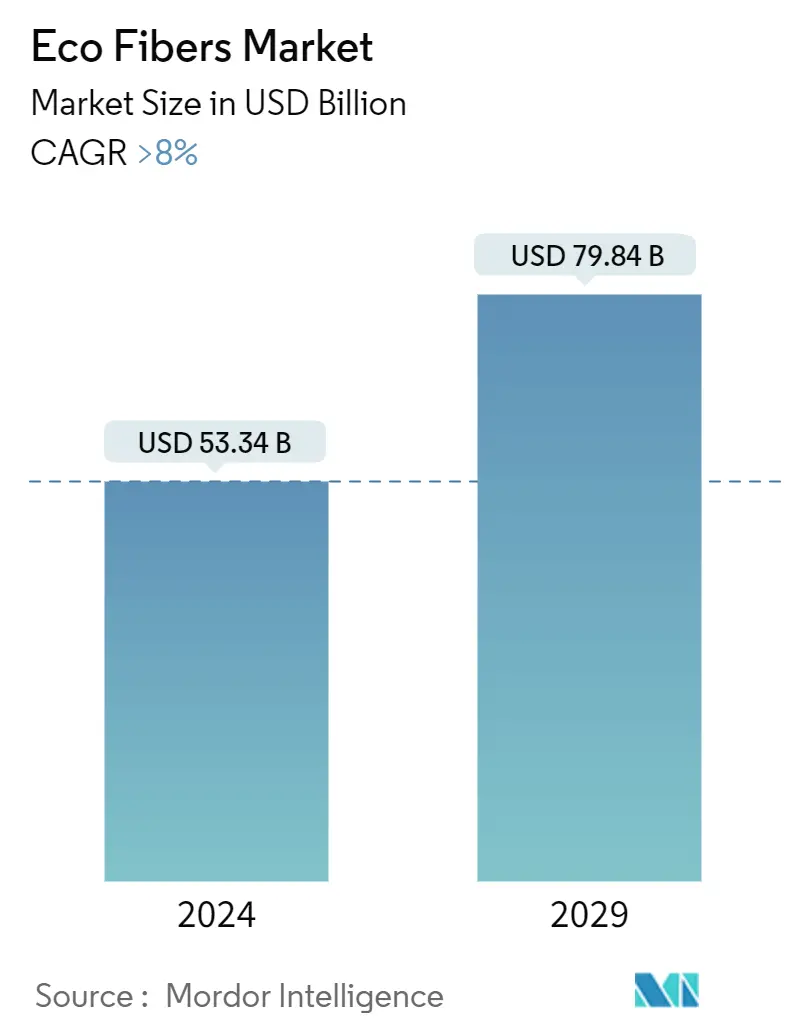
| Study Period | 2019 - 2029 |
| Market Size (2024) | USD 53.34 Billion |
| Market Size (2029) | USD 79.84 Billion |
| CAGR (2024 - 2029) | 8.00 % |
| Fastest Growing Market | Asia Pacific |
| Largest Market | Asia Pacific |
Major Players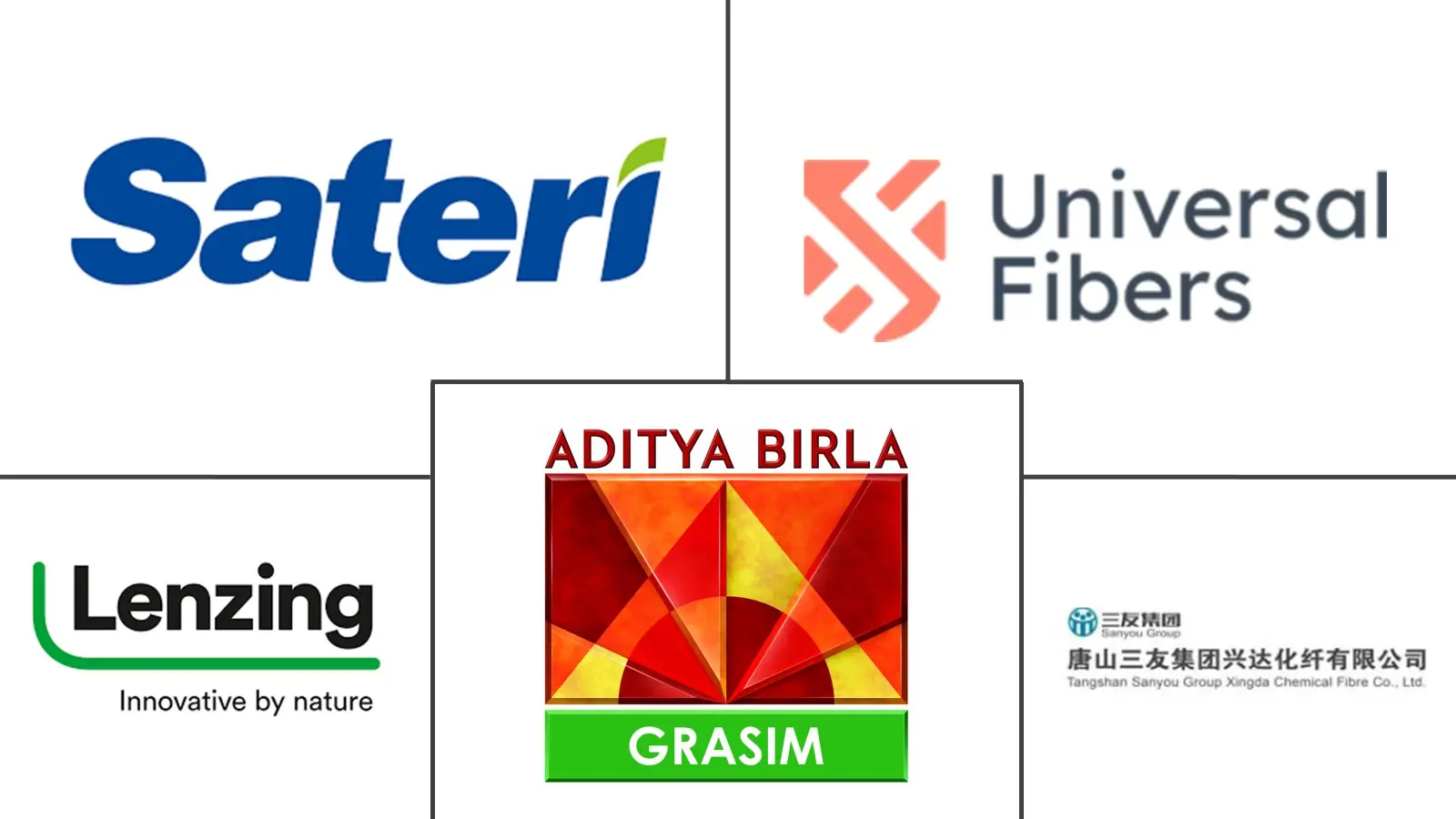
*Disclaimer: Major Players sorted in no particular order |
Eco Fibers Market Analysis
The Eco Fibers Market size is estimated at USD 53.34 billion in 2024, and is expected to reach USD 79.84 billion by 2029, growing at a CAGR of greater than 8% during the forecast period (2024-2029).
The eco fibers market was negatively impacted by COVID-19 in 2020. The textile industry was one of the industries to be worst affected by the pandemic, with business orders of garments dropping by double-digit numbers in the global market. However, the governments of most countries initiated various schemes to revive the sector, which later led to substantial growth and improvement in the sector. For instance, in Europe, the European Union (EU) and Better Work, a program to improve working conditions in the garment industry, decided to join efforts to improve working conditions in countries such as Bangladesh and Vietnam. Such initiatives helped revive the sector and consequently boosted eco-fiber demand.
Over the long run, growing demand for daily and fashion wear and increasing use of eco-fiber in household applications are expected to drive the market studied.
The high cost of final products is expected to hinder the market growth of eco fibers through the coming years.
Growing demand for natural fibers in various applications is expected to create opportunities for the market in the coming years.
Asia-Pacific is expected to dominate the global eco fibers market, and it is also expected to register the fastest growth through the forecast period.
Eco Fibers Market Trends
Growing Demand from Textile Industry
- Eco-fibers are environmentally friendly and have been increasingly used in textile fabrics because of the growing global focus on improved sustainability.
- Eco-fibers are usually made of different substances, such as hemp, flax, organic cotton, and bamboo, which are used in the production of fabrics. Products, such as organic cotton, are gaining traction and serve as a sustainable alternative to conventional cotton in the global market.
- Organic cotton production initially started in Turkey, and the organic cotton industry currently occupies the place of the backbone of the textile industry of many developing countries. The sector has also played an important role in boosting the economies of a few developing countries.
- According to the International Journal of Novel Research and Development, cotton production in India is projected to reach 7.2 million tons (43 million bales of 170 kg each) by 2030, driven by increasing consumer demand. Additionally, the National Bureau of Statistics of China stated that China produced nearly 5.98 million tonnes of cotton in 2022, up 4.3% yearly.
- Bamboo fiber works naturally as an anti-bacterial material and has properties of bacteriostatic and deodorant. Additionally, bamboo fibers offer permeability, a soft feel, and easy straightening and have excellent dye and pigmentation color effect properties to fabrics.
- Increasing demand for comfort in daily wear, technological advancements in fashion fabrics, and government regulations on textile chemicals in developed regions are driving the demand for innovations in the textile industry, which, in turn, is expected to drive the market for eco fibers through the years to come.
- According to the Confederation of Indian Industry (CII), India is the world’s second-largest producer of textiles and garments and has a 4% share of the global trade in textiles and apparel. Furthermore, the textiles and apparel industry contributes 2.3% to India's GDP, 13% to industrial production, and 12% to exports.
- Furthermore, the United States' textile and apparel shipments totaled USD 65.8 billion in 2022. The country is the third largest exporter of textile-related products in the world. Fiber, textile, and apparel exports were USD 34.0 billion in 2021.
- Thus, all such factors are expected to drive the eco fibers market during the forecast period.
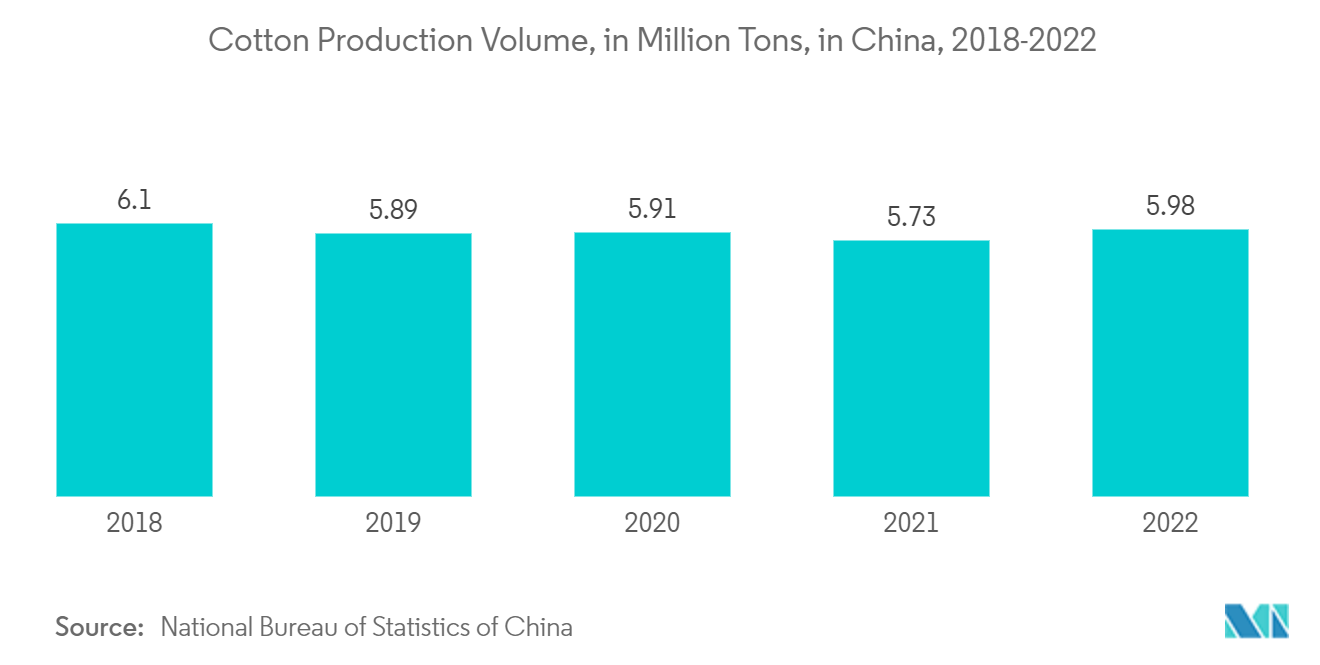
Asia-Pacific to Dominate the Market
- Asia-Pacific is expected to dominate the global market, largely driven by the highly developed textile industry in China and India. Moreover, manufacturers prefer to set up manufacturing units in countries like China, India, Bangladesh, and Pakistan, owing to high cotton production and availability of cheap labor.
- Growing environmental issues because of various chemicals used in textiles and a large proportion of the population getting affected by various diseases are increasing the demand for eco fibers in different applications. Eco fibers are human-friendly and cause no damage to the environment, even during the production phase.
- Eco-fibers have also been used for household applications, such as tarpaulins, geotextiles, bags, carpets, and furniture materials. China majorly exports its household materials to other countries and regions, like India, Pakistan, Europe, etc.
- Furthermore, as per Invest India's analysis, India is set to achieve USD 250 billion in textiles production and USD 100 billion in exports by 2030.
- Packaging is another sector where the demand for eco-friendly fibers is recently gaining momentum due to the increasing demand for sustainable packaging. According to Protega Global Ltd., in January 2023, the percentage of consumers demanding sustainable packaging was risen to 81%.
- Packaging is considered the fifth largest sector in the Indian economy and is growing around 22-25% per annum, according to the Packing Industry Association of India (PIAI).
- Additionally, according to World Trade Organization (WTO) data, China leads the global eco-fiber textile market.
- Overall, such factors are expected to drive market growth during the forecast period.
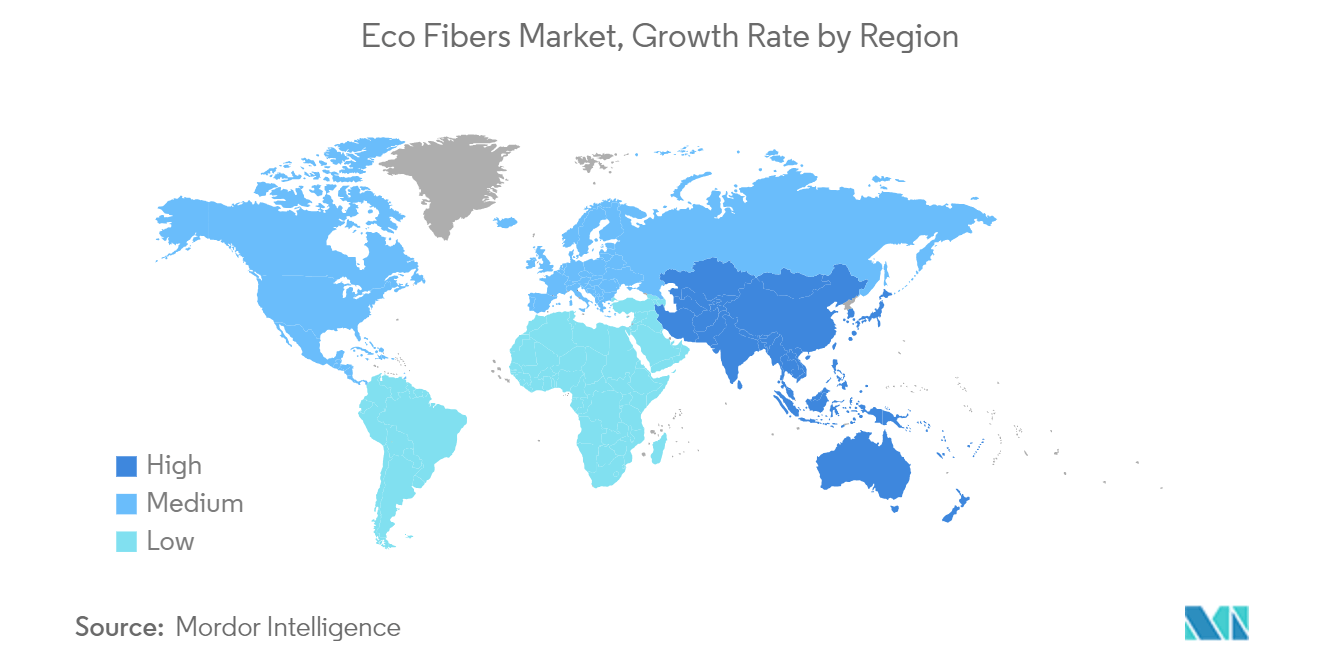
Eco Fibers Industry Overview
The global eco fibers market is partially consolidated in nature, with few players having a significant share in the global market. Some of the major players in the global market (not in any particular order) include SATERI and Aditya Birla Management Corporation Pvt. Ltd (Grasim Industries Limited), Universal Fibers Inc., LENZING AG (ECOVERO), and Tangshan Sanyou Group Xingda Chemical Fibre Co. Ltd., among others.
Eco Fibers Market Leaders
-
LENZING AG (ECOVERO)
-
SATERI
-
Aditya Birla Management Corporation Pvt. Ltd (Grasim Industries Limited)
-
Universal Fibers Inc.
-
Tangshan Sanyou Group Xingda Chemical Fibre Co. Ltd
*Disclaimer: Major Players sorted in no particular order
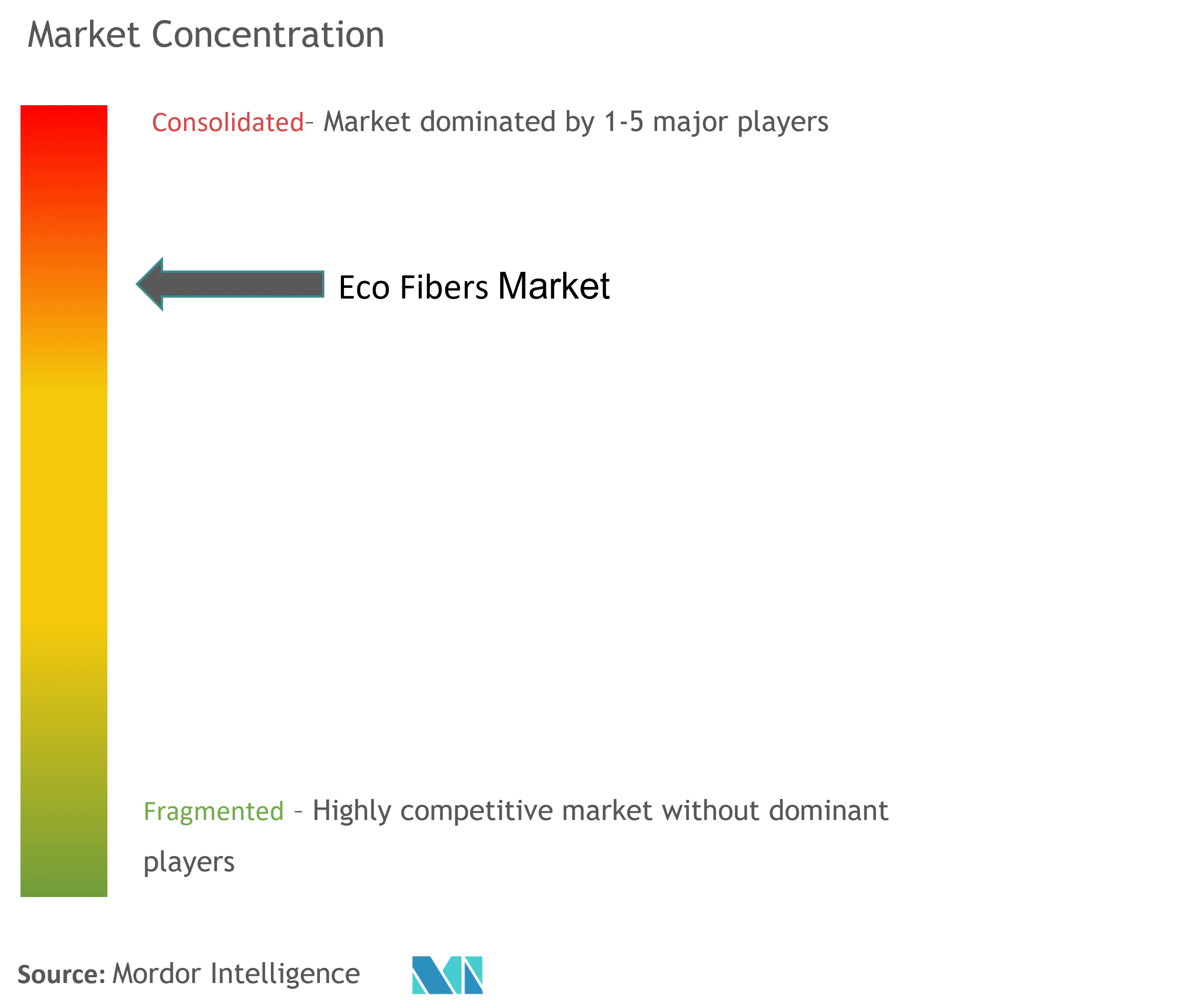
Eco Fibers Market News
- December 2022: The Lenzing Group and Renewcell, the Swedish textile-to-textile recycling pioneer, signed a multi-year supply agreement to accelerate the transition of the textile industry from a linear to a circular business model.
- November 2022: Lenzing Group celebrated a key milestone as the production of LENZING ECOVERO branded viscose fibers reached over 300,000 tons since the brand's inception in 2017. The company also focussed on achieving even higher capacity in 2023 with the addition of a new site for LENZING ECOVERO fiber production.
Eco Fibers Market Report - Table of Contents
1. INTRODUCTION
- 1.1 Study Assumptions
- 1.2 Scope of the Study
2. RESEARCH METHODOLOGY
3. EXECUTIVE SUMMARY
4. MARKET DYNAMICS
-
4.1 Drivers
- 4.1.1 Growing Demand from Daily and Fashion Wear
- 4.1.2 Increasing Household Applications
-
4.2 Restraints
- 4.2.1 High Cost of Final Products
- 4.3 Industry Value Chain Analysis
-
4.4 Porter's Five Forces Analysis
- 4.4.1 Bargaining Power of Suppliers
- 4.4.2 Bargaining Power of Consumers
- 4.4.3 Threat of New Entrants
- 4.4.4 Threat of Substitute Products and Services
- 4.4.5 Intensity of Competitive Rivalry
5. MARKET SEGMENTATION (Market Size in Value)
-
5.1 Type
- 5.1.1 Organic Fibers
- 5.1.2 Recycled Fibers
- 5.1.3 Other Types
-
5.2 Application
- 5.2.1 Textiles
- 5.2.2 Industrial
- 5.2.3 Household and Furnishing
- 5.2.4 Other Applications
-
5.3 Geography
- 5.3.1 Asia-Pacific
- 5.3.1.1 China
- 5.3.1.2 India
- 5.3.1.3 Japan
- 5.3.1.4 South Korea
- 5.3.1.5 ASEAN Countries
- 5.3.1.6 Rest of Asia-Pacific
- 5.3.2 North America
- 5.3.2.1 United States
- 5.3.2.2 Canada
- 5.3.2.3 Mexico
- 5.3.3 Europe
- 5.3.3.1 Germany
- 5.3.3.2 United Kingdom
- 5.3.3.3 Italy
- 5.3.3.4 France
- 5.3.3.5 Russia
- 5.3.3.6 Rest of Europe
- 5.3.4 South America
- 5.3.4.1 Brazil
- 5.3.4.2 Argentina
- 5.3.4.3 Rest of South America
- 5.3.5 Middle-East and Africa
- 5.3.5.1 Saudi Arabia
- 5.3.5.2 South Africa
- 5.3.5.3 Rest of Middle-East and Africa
6. COMPETITIVE LANDSCAPE
- 6.1 Mergers and Acquisitions, Joint Ventures, Collaborations, and Agreements
- 6.2 Market Share (%)**/Ranking Analysis
- 6.3 Strategies Adopted by Leading Players
-
6.4 Company Profiles
- 6.4.1 LENZING AG
- 6.4.2 Grasim Industries Limited
- 6.4.3 Pilipinas Ecofiber Corporation
- 6.4.4 Polyfibre Industries Private Limited
- 6.4.5 SATERI
- 6.4.6 Shanghai Tenbro Bamboo Textile Co.,Ltd.
- 6.4.7 Tangshan Sanyou Group Xingda Chemical Fiber Co.,Ltd.
- 6.4.8 TEIJIN FRONTIER CO., LTD.
- 6.4.9 Universal Fibers, Inc.
- 6.4.10 Wellman Advanced Materials
- *List Not Exhaustive
7. MARKET OPPORTUNITIES AND FUTURE TRENDS
- 7.1 Growing Demand for Natural Fibers in Various Applications
- 7.2 Other Opportunities
Eco Fibers Industry Segmentation
Eco-fibers, or eco-friendly fabrics, are fibers that are not grown chemically or with the help of pesticides. They are millable, moldable, and disease-free. Such fibers are increasingly adopted in textile manufacturing owing to their environment and health-friendly nature in the flow processes.
The eco fibers market is segmented by type (organic fibers and recycled fibers), application (textiles, industrial, household and furnishing, and other applications {shoes, consumer goods, etc.}), and geography (Asia-Pacific, North America, Europe, South America, and the Middle East and Africa). The report also covers the market size and forecasts for the market in 17 countries across the globe.
The report offers market size and forecasts for the Eco Fibers market in value (USD) for all the above segments.
| Type | Organic Fibers | |
| Recycled Fibers | ||
| Other Types | ||
| Application | Textiles | |
| Industrial | ||
| Household and Furnishing | ||
| Other Applications | ||
| Geography | Asia-Pacific | China |
| India | ||
| Japan | ||
| South Korea | ||
| ASEAN Countries | ||
| Rest of Asia-Pacific | ||
| Geography | North America | United States |
| Canada | ||
| Mexico | ||
| Geography | Europe | Germany |
| United Kingdom | ||
| Italy | ||
| France | ||
| Russia | ||
| Rest of Europe | ||
| Geography | South America | Brazil |
| Argentina | ||
| Rest of South America | ||
| Geography | Middle-East and Africa | Saudi Arabia |
| South Africa | ||
| Rest of Middle-East and Africa |
Eco Fibers Market Research FAQs
How big is the Eco Fibers Market?
The Eco Fibers Market size is expected to reach USD 53.34 billion in 2024 and grow at a CAGR of greater than 8% to reach USD 79.84 billion by 2029.
What is the current Eco Fibers Market size?
In 2024, the Eco Fibers Market size is expected to reach USD 53.34 billion.
Who are the key players in Eco Fibers Market?
LENZING AG (ECOVERO), SATERI, Aditya Birla Management Corporation Pvt. Ltd (Grasim Industries Limited), Universal Fibers Inc. and Tangshan Sanyou Group Xingda Chemical Fibre Co. Ltd are the major companies operating in the Eco Fibers Market.
Which is the fastest growing region in Eco Fibers Market?
Asia Pacific is estimated to grow at the highest CAGR over the forecast period (2024-2029).
Which region has the biggest share in Eco Fibers Market?
In 2024, the Asia Pacific accounts for the largest market share in Eco Fibers Market.
What years does this Eco Fibers Market cover, and what was the market size in 2023?
In 2023, the Eco Fibers Market size was estimated at USD 49.07 billion. The report covers the Eco Fibers Market historical market size for years: 2019, 2020, 2021, 2022 and 2023. The report also forecasts the Eco Fibers Market size for years: 2024, 2025, 2026, 2027, 2028 and 2029.
Eco Fibers Industry Report
Statistics for the 2024 Eco Fibers market share, size and revenue growth rate, created by Mordor Intelligence™ Industry Reports. Eco Fibers analysis includes a market forecast outlook 2029 and historical overview. Get a sample of this industry analysis as a free report PDF download.



